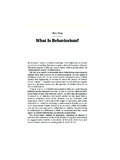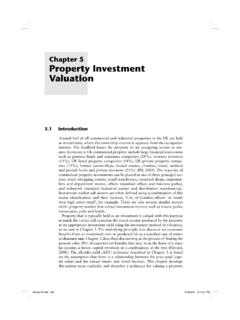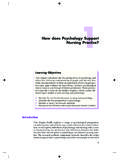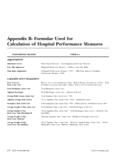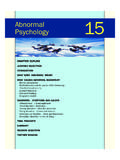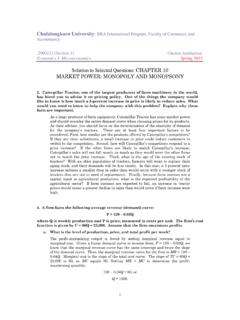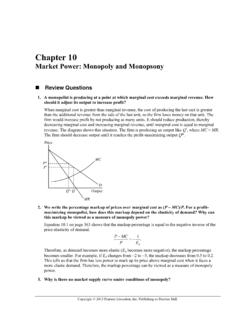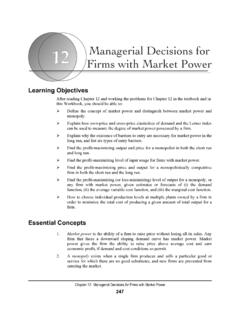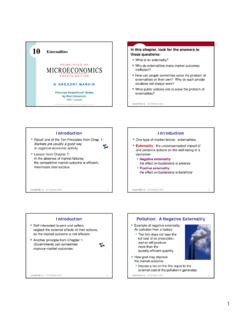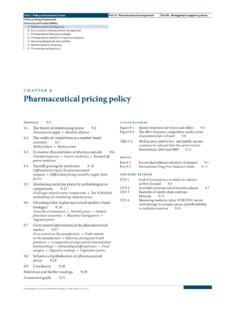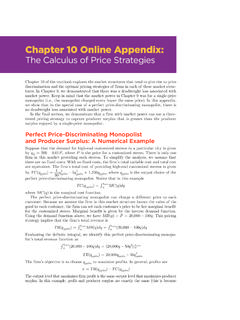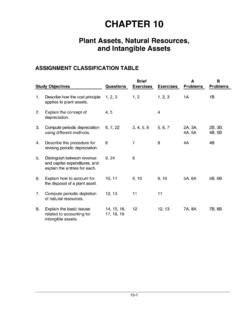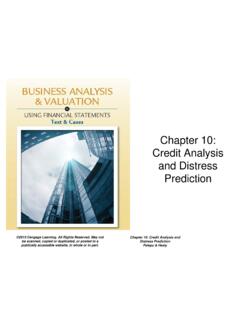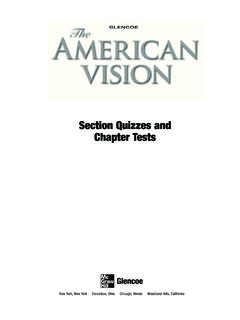Transcription of Chapter 20: Advertising, Market Power, and …
1 153 Chapter 20: advertising , Market power , and information learning objectives Students should learn to: 1. Identify several ways in which advertising increases the demand for a product: a. Differentiates the product from substitutes so that a better match between consumer and product will occur and price differences will matter less. b. Modifies the image of the product so that the consumer gets more utility from the same level of actual physical service. c. Provides information about the product so that the consumer s preferences for it are actually modified or provides information so that the consumer can better compare the product with their preferences. d. Provides information so that the consumer is aware that the product exists at a certain location for a specific price. 2. Discuss stylized facts about advertising : a. There is a positive correlation between advertising in consumer goods industries and profitability in these industries.
2 B. The pattern of advertising across industries (including advertising to sales ratios) has been stable over time. c. High advertising to sales ratios tend to be linked with low price elasticities of demand. 3. Explain the incentives and disincentives for a firm to engage in fraudulent advertising and relate these to the time value of money. 4. Discuss why it may be difficult to prosecute firms for false advertising . a. Verifiability of claims b. Bankruptcy protection c. Ability to disappear 5. Explain why the advertising to sales ratio for an industry is a more useful gage of advertising intensity than the total dollars spent on advertising . 6. Explain how advertising may give a firm some monopoly power . 7. Discuss some of the fundamental problems for economic analysis if advertising actually changes fundamental tastes. The student will be able to relate this argument to one about the benefits of technological progress.
3 8. Differentiate image advertising from informational advertising . 9. Explain the Nelson model of quality signaling through advertising a. Experience goods and the need to get consumers to try them b. Importance of repeat purchases c. Discount rates and the value of expenditures versus repeat sales later d. Consumer s rational reaction to high levels of advertising e. Incentive for firms with very high price-cost margins and low quality products to advertise for a one-shot profit bonanza 154 10. Explain how price as well as advertising expenditures may be a signal of quality. The student will be able to explain the empirical literature that shows minimal positive correlation between price and quality. 11. Discuss ways in which advertising is a complementary good with the product to which it applies. a. Crowd appeal effect b. information about how to use the product 12.
4 Explain and contrast the following categorizations of goods and relate them to advertising expenditures. a. Convenience goods b. Shopping goods c. Experience goods d. Search goods Suggested Lecture Outline: Spend two fifty-minute lectures on this Chapter Lecture 1: 1. Costs and benefits of advertising 2. Some stylized facts 3. Truth in advertising , verification, and regulation 4. Conditions that encourage fraudulent advertising i) purchase necessary to evaluate quality ii) difficult to recover damages general data and views about advertising i) useful information versus unneeded product differentiation ii) fundamental and acquired tastes iii) prisoner s dilemmas in advertising 5. Nelson model i) need for initial advertising for experience goods ii) advertising as a signal of quality iii) Pricing as a signal of quality (Milgrom and Roberts) 6. Empirical facts on advertising (pricing) and quality Lecture 2: 1.
5 advertising and monopoly power 2. advertising as a complementary good i) consumption externalities or the crowd appeal (snobbery) effect ii) information effect and brand recognition 3. advertising and crowd appeal i) more utility from an advertised good ii) spatial model with advertisement enhanced value iii) finding the marginal consumer and the quantity demanded 155 4. information flow and the probability of receiving information 5. Monopolist s profit maximizing choice of advertising i) linear inverse demand with advertising as a price shifter ii) Dorfman-Steiner condition and advertising -sales ratios iii) low price elasticities and advertising intensity iv) advertising sales as a ratio of elasticities and constancy of ratio Suggestions for the Instructor: 1. Students are constantly bombarded by advertising . Use their experiences to generate a discussion about the benefits and costs of advertising .
6 Some possible issues to discuss are: a. How many leave the room or change the station when an advertisement comes on the television or radio? b. How many can remember whether a sentimental greeting card advertisement was for Hallmark or American Greetings? c. What is Nike advertising in a television spot that doesn t mention shoes? d. How many believe that McDonald s has the most preferred French fries? e. How many check the flyer at the front of the store before going shopping? f. How many have bought at a blue light special? g. What do they think is the point of the advertisement that says image is everything ? h. How many have watched an infomercial in the last two weeks, in the last month? i. How many have seen a television advertisement for a local business in the last week? How many have seen a television advertisement for a national manufacturing firm in the last two days?
7 J. How many have read Consumer Reports before making a purchase? 2. The section on consumer fraud is fascinating to students. The material in the text is interesting and to the point. Don t get caught up in too much discussion in class on this point, or the hour of lecture will be gone with war stories. 3. The section on fraudulent advertising is an excellent place to discuss issues related to observability and verification. One could easily relate this material to a discussion of regulation in general. Other good examples are pollution control, regulation of a public utility, principle-agent problems, etc. 4. The nutritional value of food is a good topic on which to base a discussion of truthful versus fraudulent, versus unclear, versus non-verifiable, versus not easily verifiable, versus vague advertising . The current nutritional labels on most foods are partly a result of this debate.
8 5. The United States Department of Agriculture recently proposed a set of guidelines for organically or naturally grown food items. This has resulted in a huge debate with both consumer and producer groups opposing the guidelines. Discuss with the students why they think this is the case. 6. Engage the students in a debate about whether a particular advertising campaign is designed to point out a real advantage of a product (differentiation that should clearly increase demand) or to simply convince consumers that this particular brand is a better buy for the money. While few of these debates have clear answers, the discussion is interesting. Some possible suggestions are listed below. 156 a. Quicker braking for a specific type of tire b. Presentation of taste test data on French fries c. Presentation of sales data on a cola product d. Demonstration of close shave by sexy model e.
9 Testimonials by adults who still like a kid s cereal f. Laundry detergent commercial showing items washed with two different brands g. Liquid soap commercial showing celebrity lathering themselves h. Athletic apparel commercial showing big stars more or less in the nude 7. Conduct an in-class survey about how many students typically buy Kraft Macaroni and Cheese versus a house brand. One could also do this for toasted oat cereals, or pineapple chunks, or yogurt, etc. 8. New products fit the experience goods model (Nelson) since the manufacturer must get that initial sale in order to get any repeat customers. Think about the advertising that a new retail outlet may elect for a grand opening, special introductory sale, etc. 9. Students sometimes think of automobiles as an exception to the idea that search goods don t have a lot of advertising since they are familiar with lots of television and magazine commercials for cars.
10 Point out that the sales revenue of car manufacturers is also very large and that the data shows a low ratio of advertising to sales. 10. Be sure to discuss the incentives for fraudulent advertising by a fly-by-night firm with a high discount rate and large immediate profits. Food supplements are a good case in point. 11. In discussing price as a signal, ask the students how many of them regularly shop for their clothes at KMART. Then ask them to close their eyes and ask the question again. Ask them how many of them tell their friends where they buy their clothes. Ask them how many of them selectively tell their friends where they buy their clothes. 12. Carefully differentiate the difference between advertising that gives utility to the consumer versus advertising that signals what does give utility to a consumer. 13. The model on crowd appeal is a nice application of the spatial model.


